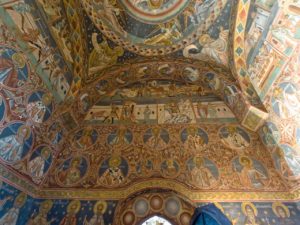To download a printable Adobe Acrobat version click on this link The_Great_Train_Journey-week4.pdf (four A4 pages)
Clicking on any of the small photographs will open a larger version in another window
Did we get back safely from our 10,000km Great Train Journey, you ask? Yes, thank-you. Our Inter-rail pass lasted 30 days, and on the evening of the 30th day our taxi from Saint Dié station was duly approaching our shuttered-up house. The grass had grown lush and tall since our departure, and the house and garden looked like they used to in their early days as a holiday-only retreat. And oddly there were no cows.
Were our dreams fulfilled? In terms of a rail journey across Europe and east to Lake Van, as follow-up to our long-ago rail journeys round India, it was every bit as much fun, though perhaps less elegant than I’d hoped.  We were in Erzurum when we last wrote. And as we waited at Erzurum railway station for the delayed train back to Istanbul, there was an exhibition of large sepia photos of the building of the railway line from Istanbul to Medina (never quite reaching the goal of Mecca), which gave an impression of earlier Ottoman and German dreams of grandeur and empire. T E Lawrence (of Arabia) was also there looking heroic and menacing, as was a film-still of a wrecked train. Sadly, the glamour of rail travel is in danger of vanishing along with the steam engines. Most of the Romanian and Turkish rolling stock was shabby and grubby and dining cars were only occasionally present. However, the new high-speed trains should restore some of the glamour and excitement. We travelled alongside the completed section of the Ankara to Istanbul high-speed track. And later during the return journey, some of the new Austrian and German trains restored the excitement and comfort of rail travel.
We were in Erzurum when we last wrote. And as we waited at Erzurum railway station for the delayed train back to Istanbul, there was an exhibition of large sepia photos of the building of the railway line from Istanbul to Medina (never quite reaching the goal of Mecca), which gave an impression of earlier Ottoman and German dreams of grandeur and empire. T E Lawrence (of Arabia) was also there looking heroic and menacing, as was a film-still of a wrecked train. Sadly, the glamour of rail travel is in danger of vanishing along with the steam engines. Most of the Romanian and Turkish rolling stock was shabby and grubby and dining cars were only occasionally present. However, the new high-speed trains should restore some of the glamour and excitement. We travelled alongside the completed section of the Ankara to Istanbul high-speed track. And later during the return journey, some of the new Austrian and German trains restored the excitement and comfort of rail travel.
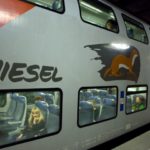
Vienna Wiesel double-decker train
The buffet car of the Railjet between Vienna and Munich, with its curving blue seats and pink walls was almost as seductive as those long-ago glimpses of the Golden Arrow dining cars. And in Vienna itself, where we spent a whole morning riding the trams (with the excuse of a 24 hour ticket and John’s injured ankles), we spotted a double decker “weasel” train, so changed onto that and I fulfilled another dream of travelling upstairs on a train. (It was from there that we had a view every bit as dramatic as that in The Third Man, of the famous Ferris wheel).
Another dream had been to sense the fabulous Byzantium/ Constantinople lurking beneath modern Istanbul. We’d been fired up by the Royal Academy’s Byzantium exhibition back in January. But it was hard to piece together a picture of the old city. The archaeological museum is magnificent, but even that did not provide an overall picture. It feels as if over a thousand years of Byzantine history have little relevance to Turkey. The city walls, first spotted from the train, were striking reminders of the size of Constantinople. But unfortunately the building of the same railway line had destroyed some of the ruins of the old Bucoleon Palace by the sea (and former harbour). 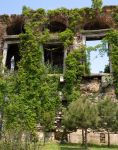 When we were first in Istanbul, we enjoyed the restored Byzantine churches we’d seen. On our return from eastern Turkey it was good to have more time in Istanbul, to look for further remains of the old Byzantium. Our guide book warned that ruins of the Bucoleon Palace are now the haunt of tramps, and indeed, as we approached, one gentleman was spreading out his washing to dry on the old stone palace walls.
When we were first in Istanbul, we enjoyed the restored Byzantine churches we’d seen. On our return from eastern Turkey it was good to have more time in Istanbul, to look for further remains of the old Byzantium. Our guide book warned that ruins of the Bucoleon Palace are now the haunt of tramps, and indeed, as we approached, one gentleman was spreading out his washing to dry on the old stone palace walls.
As we were finding our way round the modern city, three obelisks and columns kept looming up in unexpected places, making us realise that we weren’t quite where we thought we were, but were back on the site of the old hippodrome. It got quite comical in the end. But somehow, with all the big white tourist coaches waiting outside the nearby Blue Mosque, and the throngs being guided round the obelisks, it was hard to get a sense of the old hippodrome (though it would have been equally packed). But as we walked back from the remains of the old palace walls, our eyes sharpened, we  came across a huge curved wall above a street market, which must have been the semi-circular turn of the old race course. Another fragment of former grandeur. And of course the uncovered mosaics in the remaining Byzantine churches were glorious, especially with the glowing golds. Maybe one day the depressingly unloved Hagia Sophia will also be restored to glory.
came across a huge curved wall above a street market, which must have been the semi-circular turn of the old race course. Another fragment of former grandeur. And of course the uncovered mosaics in the remaining Byzantine churches were glorious, especially with the glowing golds. Maybe one day the depressingly unloved Hagia Sophia will also be restored to glory.
And there were unexpected pleasures in Istanbul. It took a while to work out the ferry boats with all their different quays, but they were a picturesque and cool way of getting around. Returning from the east in the very late evening, it was great to come out of the railway station, step onto a ferry, and realise that the skyline was this time a familiar one in which we could almost pick out our hotel in the streets below Hagia Sophia. We later spent a day going up the Bosphorus and back. Wandering the narrow streets between our hotel and the sea front Bucoleon Palace was another pleasure, with the old wooden (former merchants’) houses jutting out over the streets. 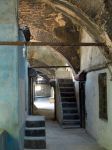 And the scale of the old caravanserais between the Grand Bazaar and the Spice Bazaar was stunning. Most of them are very ramshackle now. Dark crumbling staircases lead up to rooms off the cool, arcaded corridors. Through open doorways men can faintly be seen in the gloom, machining trousers and raincoats or hammering away at silver dinner services or trophies. It was easy to imagine all kinds of dramatic film chases through these arcades, or sinister murder stories.
And the scale of the old caravanserais between the Grand Bazaar and the Spice Bazaar was stunning. Most of them are very ramshackle now. Dark crumbling staircases lead up to rooms off the cool, arcaded corridors. Through open doorways men can faintly be seen in the gloom, machining trousers and raincoats or hammering away at silver dinner services or trophies. It was easy to imagine all kinds of dramatic film chases through these arcades, or sinister murder stories.
And did I get my special birthday meal on the train from Erzurum to Istanbul? The sleeping car promised well as we got on the train, for it was the most modern so far, a soothing pale grey colour, and even equipped with a small fridge. And for the first time the attendant presented us with some sustenance, – sour cherry juice, biscuits and chocolate. The scenery that evening was spectacular as we left behind the snow capped mountains, following the Euphrates through gorges, plunging into tunnels (there must have been over 150), and even having the sky briefly radiant with a double rainbow arching behind us above the gorge tunnels. The journey of a couple of our travelling companions made ours seem quite tame, as they were en route from Japan to Austria. But sadly the omelette and chips or kebap and rice, washed down with Nescafe in the dining car did not feel over-festive. So after spending our first day back in Istanbul at the Topkapi Palace and its harem, we dined in style on a roof-top restaurant overlooking 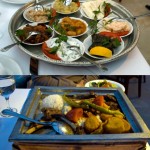 the Sea of Marmara on one side and the Blue Mosque on the other. The tray of traditional starters were all delicious, the Sultan’s taste (lamb cooked in five different ways) arrive in an elaborate lidded copper dish, along with a salad. The desert was a succulent selection but the crowning glory was the home-made cherry liqueur which was so delicious that we commented on it, so more was immediately brought. That definitely beat omelette, chips and Nescafe!
the Sea of Marmara on one side and the Blue Mosque on the other. The tray of traditional starters were all delicious, the Sultan’s taste (lamb cooked in five different ways) arrive in an elaborate lidded copper dish, along with a salad. The desert was a succulent selection but the crowning glory was the home-made cherry liqueur which was so delicious that we commented on it, so more was immediately brought. That definitely beat omelette, chips and Nescafe!
In general, 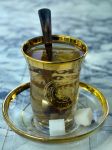 we found it surprisingly hard to find good restaurant food, especially at reasonable prices, and in the Sultanahmet area where we stayed. However occasional dishes like vine leaves stuffed with cherries or lamb and sour plum casserole were a wonderful exception to the ubiquitous kebaps and pideci (pizzas). And we did relish stopping for an apple tea and baklava in the afternoon heat. Not to mention the large rooftop breakfasts which provided a great start to the day.
we found it surprisingly hard to find good restaurant food, especially at reasonable prices, and in the Sultanahmet area where we stayed. However occasional dishes like vine leaves stuffed with cherries or lamb and sour plum casserole were a wonderful exception to the ubiquitous kebaps and pideci (pizzas). And we did relish stopping for an apple tea and baklava in the afternoon heat. Not to mention the large rooftop breakfasts which provided a great start to the day.
How about a birthday present with a difference? Well, a large rug would have been tempting. But we must be loosing our stamina for the hassle of bargaining and the patter of men trying to lure you into their unique emporium. You could fritter away a lifetime with carpet salesmen and cups of tea. And we never spotted the perfect rug (and never saw any being sold). The other temptation was a tile. 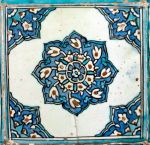 Yes, just a single tile. We’d seen such wonderful tiles in the mosques and fountains and the Topkapi Palace, that it would have been fun to incorporate one of the Iznik tiles into our bathroom back in Entre-deux-Eaux. But with such ridiculous starting prices as 100 euro, it was hardly worthwhile to open the bargaining. So I shall content myself with ordering some more Orhan Pamuk novels, and try out Barbara Nadel’s Istanbul crime stories.
Yes, just a single tile. We’d seen such wonderful tiles in the mosques and fountains and the Topkapi Palace, that it would have been fun to incorporate one of the Iznik tiles into our bathroom back in Entre-deux-Eaux. But with such ridiculous starting prices as 100 euro, it was hardly worthwhile to open the bargaining. So I shall content myself with ordering some more Orhan Pamuk novels, and try out Barbara Nadel’s Istanbul crime stories.
So had we enjoyed Istanbul despite the bazaar hustlers and the partial neglect of the Byzantine heritage? We really had. It was a great time (especially on our return when it was quieter than our stay a few weeks earlier when much of Europe seemed to be visiting during the public holidays) and we were sad to leave on the night train. Appropriately our parting views from the train were of the old city walls, and the illuminated Byzantine harbour excavations (discovered when tunnelling for the new metro).
We’d chosen the return route via Bucharest, Budapest and Vienna, rather that the more usual Belgrade and Sofia (Orient Express) route, as we’d heard there were often long delays in Bulgaria that way (and indeed we later heard that the Austrian couple we’d met earlier ran into delays and missed their connections on that line). Vienna would have been sacrificed had we too gone that way.
Meanwhile, had John bought new shoes in Istanbul? And what about the Sultan’s Revenge? Well, our medicine chests of diarrhoea remedies remained untouched, which was good. But the lack of footwear was (literally) John’s downfall. He’d already slipped on a wet ramp in Romania and rain-soaked cobbles in Istanbul despite the grip of his walking boots (so his wrist had been bandaged ever since). The temperature had shot up since we left Erzurum, so John was now wearing the battered sandals he’d packed at the last minute (after reading travellers tales of filthy showers and toilets). Having arrived safely at Vienna Westbahnhof, John realised he’d left his glasses on the train, so ran back to retrieve them. Maybe it was the sandals, maybe it was the forty hours of inactivity on the trains from Istanbul, maybe the lack of salt after the heat of Istanbul, but both his Achilles tendons gave way. And his glasses had gone.
We stayed in a curiously old fashioned pension in Vienna, with a huge brass bed, huge wardrobes, huge dining room table (and correspondingly huge breakfast) and a landlady with a walking stick and a resigned dog. She seemed most perturbed that John did not leave our room that first day, apart from hobbling to the restaurant over the road in the evening, which was a Hong Kong Cookhouse. (I’d in the meantime got over-baroqued by all the city’s white and gold buildings). There were no other customers at the Cookhouse, but the young woman was harassed, and frenzied shouts came from the kitchen as delivery men appeared and disappeared with freezer boxes. The next day we embarked on our tram trip from the end of our road, culminating at St Stephen’s cathedral in the centre, with an open air café, a large coffee and cake (traditional Sachertorte for John). More trams and we got out at the Upper Belvedere, to see the Klimts. But even better was the temporary exhibition in the Lower Belvedere of Alphonse Mucha. And that evening John limped down to the nearest pub/stub where we had a more typically Austrian meal – and beer. Despite John’s injury, I’m glad we didn’t miss out on Vienna.
Day 30 and our last day on the trains. Eleven hours of trains, starting with the elegant Austrian Railjet (with its buffet-car) from Vienna to Salzburg and Munich, then an inter-city from Munich to Karlsruhe. The regional express from Karlsruhe was more packed than we could have imagined at 4 p.m. on a Wednesday, even allowing for schoolchildren. But the next day was Ascension Day and, given the hot weather, everyone seemed to be taking their bicycles into the Black Forest for the weekend. Our carriage somehow fitted at least 8 bicycles and panniers in between other people’s knees and luggage – and several had to be taken off and put back on at each halt so other passengers could alight. On our penultimate train (a regional all-stations) from Appenweier to Strasbourg, the German commuters got off at Kehl at the border and the French got on, and it was surprisingly exhilarating to hear French again. Safely over the Rhine, we caught the last of our trains, from Strasbourg to St Dié. Alas, taxis no longer bother to meet the trains at Saint Dié on the off-chance of trade, so we stood forlornly, before ringing for a taxi.
And the cows, which mysteriously weren’t grazing in the Entre-deux-Eaux fields? The shock news when we collected our post from Mme Laine, is that Dominique Duhaut has sold them all! He and Olivier have not managed to work harmoniously together (perhaps no surprise) and are dissolving the partnership at the end of the year. For now the cows have been sold and the fields lie uncut. It sounds as if two brothers from Taintrux and other farmers from Corcieux may between them take over the land.
And since then, our doctor has said that Achilles tendon injuries take a long time to mend, so John, like Farmer Duhaut, is taking life easily. Perhaps a different form of the sultan’s revenge so near the end of a wonderful journey?


